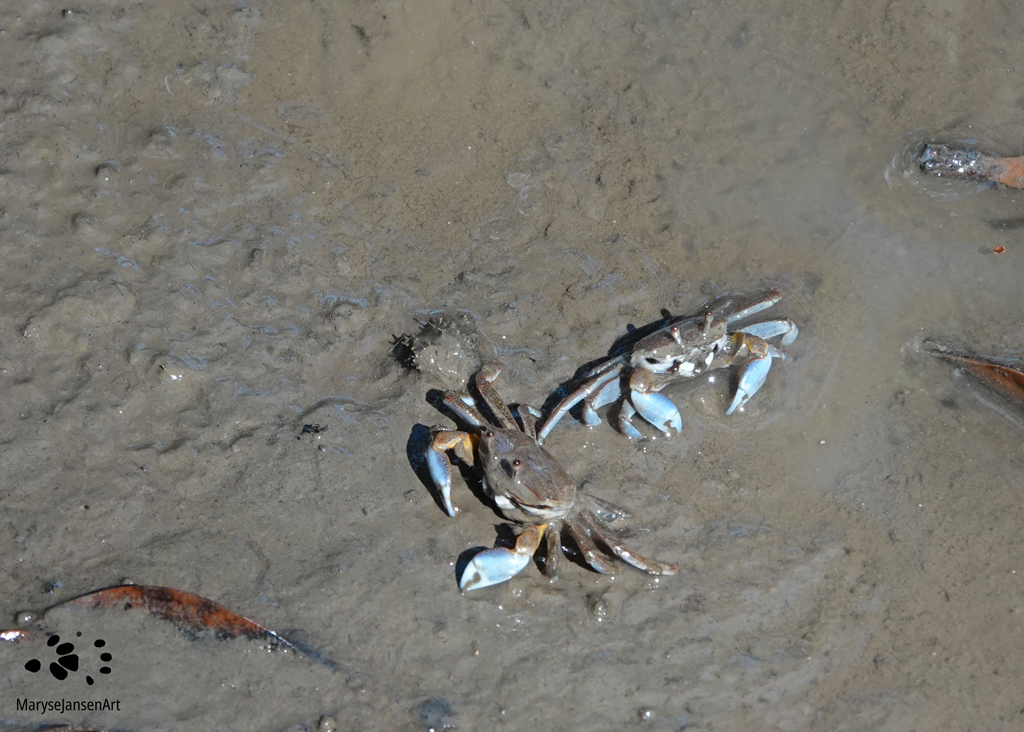Wildlife Photography with marysejansenart
Bright coloured pincers stand out in the mud
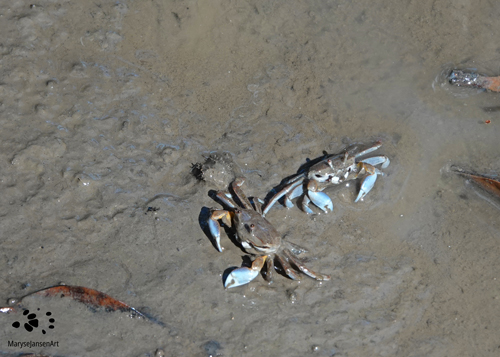
Table of Contents
A walk in the Mangroves
It’s low tide, and I’m walking through the mangrove forest. These are Grey Mangroves, I can tell by the numerous pencil roots that are sticking out of the mud like little snorkels. I hear a few birds in the tree tops, but I can’t see them. Other then that, at a first glance this place looks deserted. But nothing is less true. Taking my time to look at the muddy floor, I begin to see movement. A little mud skipper… Some tiny fish in a little puddle… And a bit further along the walk I notice it is absolutely teeming with burrowing crabs!
A lot of them have their back covered in mud, which makes it quite hard to spot them unless they are moving. But others display some beautiful coloured pincers!
Orange-clawed Fiddler Crab
There is the Orange-clawed Fiddler Crab! It a black crab, with pale legs and a prominent large, orange pincer with a white tip. Fiddler Crabs are crabs that have one pincer way larger then the other, which gives them a funny look. They tend to wave it around to either intimidate rivals or to attract mates.
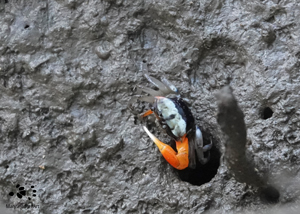
Sometimes the crab loses its large pincer in a fight. A common myth on the internet is that it is believed that when that happens, a new one will develop on the opposite side, but this is not correct. A new large claw will develop on the same side, the handedness of a Fiddler crab does not change once it has been established.
The small pincer is used for feeding. I can see the crab using it to pick up stuff from the ground and then move it into its mouth. This repeated motion gives the impression that the crab is playing the larger pincer like a fiddle, which is how it got the name Fiddler Crab! It is only the male Fiddler Crabs, that have this feature. In the females, both pincers are the same size.
You might wonder what is this ‘stuff’ that they eat? They basically take a ‘handful’ of mud and sieve out anything edible, including algae, microbes, fungi and other detritus. What’s left over is displaced in the form of a small ball of sediment. They also like to munch on mangrove litter, like the crab in the image below which is munching on a mangrove leaf. It breaks off tiny pieces with its claws and puts them in its mouth. You can see some footage of this amazing process in an earlier episode of ‘Come for a walk in the Australian Bush’ here.
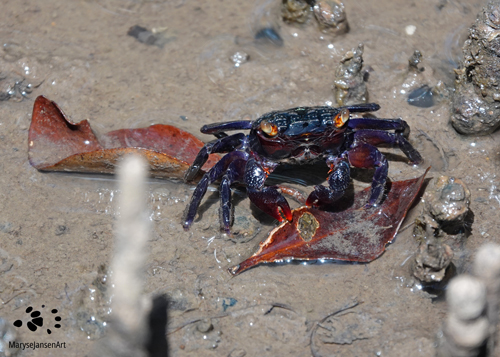
Other burrowing crabs
Other types of crabs live here in the mangroves too. All these species are semi-terrestrial. They dig burrows in the sand or mud where they hide away from predators, hot sun and high tide. When the tide is out, like now, they come out of their burrows to feed. All these crabs are fairly small in size, most of them only a couple of centimeters across their main body.
I spot some Mudflat Sentinel Crabs with their beautiful bright blue pincers! It is quite a stunning sight, amidst all that grey-brown mud! You can see that in the featured image. They walk around in that typical way that crabs do: sideways! Have you ever counted the number of legs on a crab? It is 10! Eight of these are used to walk, while the remaining two are their pincers.
Because of their wide, flat shape and exoskeleton, they don’t have much movement in the shoulder- or hip range. Their knees bend outwards, forcing them to walk sideways. This way they don’t get all those legs tangled up! They are able walk in other directions, but the sideways motion is much easier and faster for them! Not all types of crabs walk sideways, but the ones I see here certainly do!
Reproduction of burrowing crabs
The male crabs invite the females into their burrows to mate. After mating, a female crab stores the sperm until she releases her eggs. There can be hundreds of eggs at one time! The eggs become fertilized when she lets the sperm flow over them. The female crab carries the mass of fertilized eggs on her abdomen until they hatch.
The small larvae that hatch out of the eggs are called zoea. She releases the zoea and they drift away in the water as plankton. The larvae change form slightly after every molt. In the so called megalopal stage the body of the larvea becomes wider and the legs begin to stretch out to the side, which gives them a more crab-like look. They still have long abdomen stretching out behind their body like a tail. The currents of the tides help them return to the estuaries where it is easier for them to find food and hiding places.
Finally, the metamorphosis into a full crab form is complete, even though the juvenile crab will go through many more molts to grow into an adult. The whole process of metamorphosis from zoea to crab can take weeks or even months. It is quite comparable to the metamorphosis of the dragonfly!
When crabs molt, they shed their shells as they grow. Their new shell takes some time to harden and during this vulnerable time they usually hide out in their burrows. After their last molt, they are ready to mate. The males will dig their burrows in which they will stay for the rest of their life!
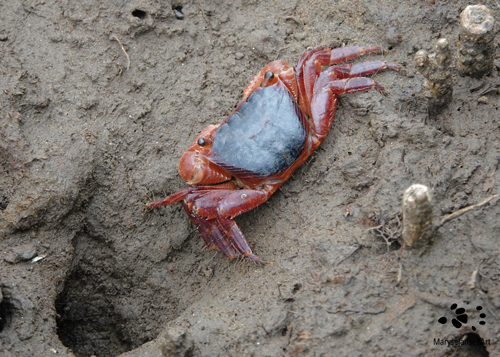
Function of burrowing crabs in the mangrove ecosystem
The soil in a mangrove forest consists of a very dense mud, which is very low in oxygen and nutrients and has very high salt levels. Not great conditions for plant growth!
When these little crabs dig their burrows, they till the soil, creating pockets of oxygen in the mud. This creates better conditions for bacteria to grow. These create nutrients that help plants to grow and also attract other tiny organisms that come and live in the burrows like worms, mulloscs and even small fish. In turn these organisms will feed on things like algae and detritus and create nutrients in the soil through their waste. The crabs themselves feed on mangrove litter, algae and detritus which also creates waste and even more nutrients in the soil.
The burrows also allow for better penetration of ground water, which helps flush out the salt and decrease the salinity. This puts less stress on the plants.
Further along in the walk, I do see some birds: Collared Kingfishers, a Little Egret and a few Australian White Ibises. And I also see that they are feeding on the crabs! This shows the other side of the crab’s place in the food chain. Without the plentiful supply of these crabs, there wouldn’t be much to eat for these birds! It is obvious that without crabs, this whole ecosystem would quickly cease to exist. They really are incredibly important and interesting creatures!
Join me on my walk in the mangroves in the latest episode of ‘Come of a walk in the Australian Bush’ and meet some of the crabs as well as the birds that seek out the crabs as their prey,
If you are interested in purchasing the featured image ‘Mudflat Sentinel Crabs’ or would like to see what it looks like on the various products, please head to my shop. Check out other images of crabs in my Australian Marine Life Gallery.

